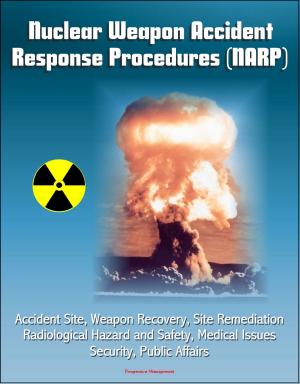Defense Nuclear Facilities Safety Board: The First Twenty Years - Hanford, Chernobyl, Three Mile Island, From the Manhattan Project to the Cold War, Rocky Flats, Savannah River, Weapons Disassembly
Nonfiction, Science & Nature, Technology, Nuclear Energy, History, Military, Nuclear Warfare| Author: | Progressive Management | ISBN: | 9781311649584 |
| Publisher: | Progressive Management | Publication: | April 8, 2015 |
| Imprint: | Smashwords Edition | Language: | English |
| Author: | Progressive Management |
| ISBN: | 9781311649584 |
| Publisher: | Progressive Management |
| Publication: | April 8, 2015 |
| Imprint: | Smashwords Edition |
| Language: | English |
Professionally converted for accurate flowing-text e-book format reproduction, this important work reviews the history of the Defense Nuclear Facilities Safety Board (DNFSB). The DNFSB an independent oversight organization within the executive branch, was created by Congress in 1988 to provide advice and recommendations to the secretary of energy regarding public health and safety at the defense nuclear facilities managed by the Department of Energy. This study captures how the Board met the competing national security, health and safety, environmental, government, and public demands placed upon DOE's defense nuclear facilities, explicating the principles and techniques the Board employed to efficiently function as a federal agency and effectively fulfill the Board's unique mandate under the Atomic Energy Act of 1954, as amended. While it chronicles events, the study also serves as the tutorial for those charged with the future administration of the Board's enabling legislation, making available to the current and future leadership the philosophical and jurisprudential underpinnings of the form of governance captured in the Board's enabling legislation and the resolution of changing and sometimes opposing national requirements. The first chapter discusses the handling of safety issues in the defense nuclear complex prior to the creation of the Board. The chapter also examines historical circumstances that produced pressures to move toward more external regulation, including major accidents involving nuclear technology (especially Chernobyl), the waning of the nuclear arms race, and the lifting of the secrecy about the safety risks and environmental damage. The second chapter reviews the debates in Congress that led up to the legislative compromise that created the Board as an expert body that would act as an independent adviser to the secretary of energy, rather than as a regulator.
The third chapter describes the development of the Board's manner of proceeding when it conducted oversight, in particular, how it interacted with the Department of Energy, congressional oversight committees, and the public, and how it wielded the tools that Congress granted it to exert authority that was effectively action-forcing. The fourth chapter examines important recommendations on nuclear safety, both site-specific and complex-wide, that the Board issued to the secretary of energy, and how their follow-up was handled. The fifth chapter discusses the shift of emphasis in the Board's activities that occurred with the end of the nuclear arms race and weapons production in 1992, mainly, the shift to greater emphasis on the stabilization and safe storage of surplus nuclear materials, as well as the safe execution of weapons dismantlement. The sixth chapter focuses on the Board's advocacy of Integrated Safety Management to support longer-term, more comprehensive safety planning in the weapons complex, and the reexamination by policymakers and the Board of whether current oversight arrangements sufficed to ensure safety. In addition, the chapter examines the Board's increased technical oversight activities of design and construction projects throughout the DOE defense nuclear complex.
CHAPTER 1 - NUCLEAR SAFETY REGULATION BEFORE THE BOARD'S CREATION * NUCLEAR POLICIES, GOVERNANCE, AND MAJOR U.S. NUCLEAR LEGISLATION UP TO THE ABOLITION OF THE ATOMIC ENERGY COMMISSION * The Manhattan Project, Atomic Energy Act of 1946, and Atomic Energy Commission * The Atomic Energy Act of 1954 * Divergent Safety Regimes in the Nuclear Power Industry and the Weapons Program * NUCLEAR DOUBTS AND THE ENERGY CRISIS * The Breakup of the AEC * The Birth of the Department of Energy in the Era of Energy Crises * THE THREE MILE ISLAND SHAKEUP: AFTERMATH * CHERNOBYL BRINGS HOME THE NEED FOR SAFETY REFORMS AND STEPPED-UP OVERSIGHT IN DOE'S NUCLEAR OPERATIONS * DOE's Internal Reforms Prior to Chernobyl
Professionally converted for accurate flowing-text e-book format reproduction, this important work reviews the history of the Defense Nuclear Facilities Safety Board (DNFSB). The DNFSB an independent oversight organization within the executive branch, was created by Congress in 1988 to provide advice and recommendations to the secretary of energy regarding public health and safety at the defense nuclear facilities managed by the Department of Energy. This study captures how the Board met the competing national security, health and safety, environmental, government, and public demands placed upon DOE's defense nuclear facilities, explicating the principles and techniques the Board employed to efficiently function as a federal agency and effectively fulfill the Board's unique mandate under the Atomic Energy Act of 1954, as amended. While it chronicles events, the study also serves as the tutorial for those charged with the future administration of the Board's enabling legislation, making available to the current and future leadership the philosophical and jurisprudential underpinnings of the form of governance captured in the Board's enabling legislation and the resolution of changing and sometimes opposing national requirements. The first chapter discusses the handling of safety issues in the defense nuclear complex prior to the creation of the Board. The chapter also examines historical circumstances that produced pressures to move toward more external regulation, including major accidents involving nuclear technology (especially Chernobyl), the waning of the nuclear arms race, and the lifting of the secrecy about the safety risks and environmental damage. The second chapter reviews the debates in Congress that led up to the legislative compromise that created the Board as an expert body that would act as an independent adviser to the secretary of energy, rather than as a regulator.
The third chapter describes the development of the Board's manner of proceeding when it conducted oversight, in particular, how it interacted with the Department of Energy, congressional oversight committees, and the public, and how it wielded the tools that Congress granted it to exert authority that was effectively action-forcing. The fourth chapter examines important recommendations on nuclear safety, both site-specific and complex-wide, that the Board issued to the secretary of energy, and how their follow-up was handled. The fifth chapter discusses the shift of emphasis in the Board's activities that occurred with the end of the nuclear arms race and weapons production in 1992, mainly, the shift to greater emphasis on the stabilization and safe storage of surplus nuclear materials, as well as the safe execution of weapons dismantlement. The sixth chapter focuses on the Board's advocacy of Integrated Safety Management to support longer-term, more comprehensive safety planning in the weapons complex, and the reexamination by policymakers and the Board of whether current oversight arrangements sufficed to ensure safety. In addition, the chapter examines the Board's increased technical oversight activities of design and construction projects throughout the DOE defense nuclear complex.
CHAPTER 1 - NUCLEAR SAFETY REGULATION BEFORE THE BOARD'S CREATION * NUCLEAR POLICIES, GOVERNANCE, AND MAJOR U.S. NUCLEAR LEGISLATION UP TO THE ABOLITION OF THE ATOMIC ENERGY COMMISSION * The Manhattan Project, Atomic Energy Act of 1946, and Atomic Energy Commission * The Atomic Energy Act of 1954 * Divergent Safety Regimes in the Nuclear Power Industry and the Weapons Program * NUCLEAR DOUBTS AND THE ENERGY CRISIS * The Breakup of the AEC * The Birth of the Department of Energy in the Era of Energy Crises * THE THREE MILE ISLAND SHAKEUP: AFTERMATH * CHERNOBYL BRINGS HOME THE NEED FOR SAFETY REFORMS AND STEPPED-UP OVERSIGHT IN DOE'S NUCLEAR OPERATIONS * DOE's Internal Reforms Prior to Chernobyl















